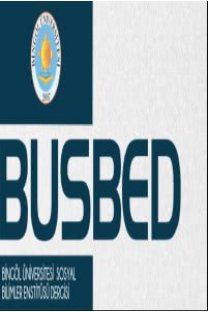ÖĞRETMEN ADAYLARI VE ÖĞRETİM ELEMANLARININ WEB 2.0 TEKNOLOJİLERİ FARKINDALIKLARI, KULLANIM SIKLIKLARI VE YETERLİKLERİNİN İNCELENMESİ
EXPLORING THE WEB 2.0 TECHNOLOGIES AWARENESS, USAGE FREQUENCIES AND COMPETENCIES OF PRESERVICE TEACHERS AND INSTRUCTORS
___
- AHMED, A. M., ALMUNIEM, A. A., & ALMABHOUH, A. A. (2016), The current use of Web 2.0 tools in university teaching from the perspective of faculty members at the college of education. International Journal of Instruction, 9(1), 179-194.
- ALHASSAN, R. (2017), Exploring the relationship between Web 2.0 tools self-efficacy and teachers’ use of these tools in their teaching. Journal of Education and Learning, 6(4), 217-228.
- BARAN, B., & ATA, F. (2013), Üniversite öğrencilerinin web 2.0 teknolojileri kullanma du-rumları, beceri düzeyleri ve eğitsel olarak faydalanma durumları, Eğitim ve Bilim, 38(169), 192-208.
- BARO, E. E., IDIODI, E. O., & ZACCHEAUS GODFREY, V. (2013), Awareness and use of Web 2.0 tools by librarians in university libraries in Nigeria, OCLC Systems & Services: International digital library perspectives, 29(3), 170-188.
- BOWER, M., HEDBERG, J. G., & KUSWARA, A. (2010), A framework for Web 2.0 learning design, Educational Media International, 47(3), 177-198.
- CHAFFEY, D. (2018), Global social media research summary 2018. https://www.smartinsights. com/social-media-marketing/social-media-strategy/new-global-social-media-research/ adre-sinden 11 Aralık 2018 tarihinde erişilmiştir.
- CHAWINGA, W. D., & ZINN, S. (2016), Use of Web 2.0 by students in the Faculty of Infor-mation Science and Communications at Mzuzu University, Malawi, South African Journal of Information Management, 18(1), 1-12.
- CORMODE, G., & KRISHNAMURTHY, B. (2008), Key differences between Web 1.0 and Web 2.0, First Monday, 13(6),
- DAVISON, D., NAGUSZEWSKI, T., PIASTA, M., SILER, B., & WARE, L. J. (2013), Nursing faculty and use of Web 2.0, Journal of Nursing Education and Practice, 3(8), 13-17.
- DIYAOLU, A. M., & RIFQAH, O. O. (2015), Investigating the educational use of Web 2.0 among undergraduates in Nigerian Private Universities. JLIS. 6(1), 69-97
- DOHN, N. B. (2009), Web 2.0: Inherent tensions and evident challenges for education, Interna-tional journal of computer-supported collaborative learning, 4(3), 343-363.
- FRANKLIN, T. AND VAN HARMELEN, M. (2007), Web 2.0 for content for learning and teaching in higher education, https://pdfs.semanticscholar.org/24ba/620460a6db0bd9284 aabf8e286be62ddb77f.pdf adresinden 18 Nisan 2018 tarihinde erişlmiştir.
- IOANNOU, A., VASILIOU, C., & ZAPHIRIS, P. (2016), Problem-based learning in multimodal learning environments: Learners’ technology adoption experiences, Journal of Educational Computing Research, 54(7), 1022-1040.
- JIMOYIANNIS, A., TSIOTAKIS, P., ROUSSINOS, D., & SIORENTA, A. (2013), Preparing teachers to integrate Web 2.0 in school practice: Toward a framework for Pedagogy 2.0. Aust-ralasian Journal of Educational Technology, 29(2),
- KAPUCU, M. S., EREN, E., & AVCI, Z. Y. (2014), Investigation of pre-service science teac-hers’ opinions about using goanimate to create animated videos, Turkish Online Journal of Qualitative Inquiry, 5(4), 23-40.
- PALAIGEORGIOU, G., & GRAMMATIKOPOULOU, A. (2016), Benefits, barriers and pre-requisites for Web 2.0 learning activities in the classroom: The view of Greek pioneer teachers, Interactive Technology and Smart Education, 13(1), 2-18.
- RICHARDSON, W. (2009), Blogs, wikis, podcasts, and other powerful web tools for classrooms (2nd ed), Thousand Oaks, CA: Corwin Press.
- SAWANT, S. (2012), The study of the use of Web 2.0 tools in LIS education in India, Library Hi Tech News, 29(2), 11-15.
- SOOMRO, K. A., ZAI, S. Y., & JAFRI, I. H. (2015), Competence and usage of Web 2.0 techno-logies by higher education faculty, Educational Media International, 52(4), 284-295.
- ŞENDAG, S., EROL, O., SEZGİN, S., & DULKADİR, N. (2015), Preservice teachers’ criti-cal thinking dispositions and web 2.0 competencies, Contemporary Educational Techno-logy, 6(3), 172-187.
- UZUNBOYLU, H., BİCEN, H., & ÇAVUŞ, N. (2011), The efficient virtual learning environ-ment: A case study of web 2.0 tools and Windows live spaces, Computers & Education, 56, 720–726.
- ISSN: 1309-6672
- Yayın Aralığı: 2
- Başlangıç: 2011
- Yayıncı: Yusuf Aydoğdu
I. BALKAN SAVAŞI’NIN DOĞU HAREKÂT ALANINDA OSMANLI ŞARK ORDUSU’NUN HARP TARİHİ BAĞLAMINDA ANALİZİ
HASAN HİLMÎ DİVANI’NDA MUHABBET KAVRAMI
TÜRKİYE’DE FAİZ ORANI VE DÖVİZ KURU İLİŞKİSİ ÜZERİNE BİR ARAŞTIRMA
ORTAYA ÇIKIŞINDAN 1960’LARA KADAR TÜRKİYE’DE SOSYOLOJİ’NİN GELİŞİMİ
TARİHÎ KENT MERKEZLERİNİN KORUMA VE GELİŞTİRME STRATEJİLERİNİN BELİRLENMESİ: GAZİANTEP ÖRNEĞİ
AHMET SALİH GÜNAYDIN, M. Faruk ALTUNKASA
TERÖR ÖRGÜTLERİNİN ÖRGÜTSEL DAVRANIŞ MODELLERİ BAĞLAMINDA EL KAİDE ÖRNEĞİ
MEHMET SEYMAN ÖNDER, CİHAT YAŞAROĞLU
DUYGU ve GÖRÜŞ MADENCİLİĞİ: SON GELİŞMELER ve 3. HAVALİMANI İÇİN BİR UYGULAMA
